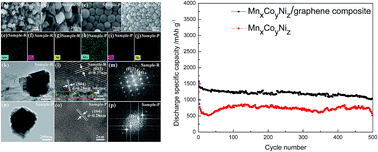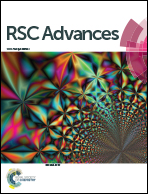The role of graphene in nano-layered structure and long-term cycling stability of MnxCoyNizCO3 as an anode material for lithium-ion batteries
Abstract
Transition metal carbonates with high energy density of lithium storage via conversion reactions as anode materials for lithium-ion batteries are a hot research focus. However, the large volume changes during the processes of insertion/extraction of Li+ ions and low electronic conductivity are great challenges. Herein, a nano-layered MnxCoyNizCO3/graphene composite and micro-spherical MnxCoyNizCO3 are synthesized via a facile hydrothermal route in the presence and absence of graphene, respectively. As an anode material, the prepared MnxCoyNizCO3/graphene composite delivers a final 500th reversible discharge specific capacity of 1046 mA h g−1 at 100 mA g−1 and furthermore presents a high value of 711 mA h g−1 at 1000 mA g−1 after 500 cycles, which shows prominent superiority in comparison with MnxCoyNizCO3 (517 mA h g−1 at 100 mA g−1 after 500 cycles) and other reported works about transition metal carbonates. The high reversible capacity, long-term cycling stability and perfect rate performance of the MnxCoyNizCO3/graphene composite should be ascribed to the existence of graphene, which plays an important role in keeping the nanostructure of the sample, enhancing the electronic conductivity of the sample, preventing the aggregation of particles and accommodating volume changes of the electrode during the cycling process. Hence, the prepared MnxCoyNizCO3/graphene composite is a promising anode material for lithium-ion batteries.



 Please wait while we load your content...
Please wait while we load your content...